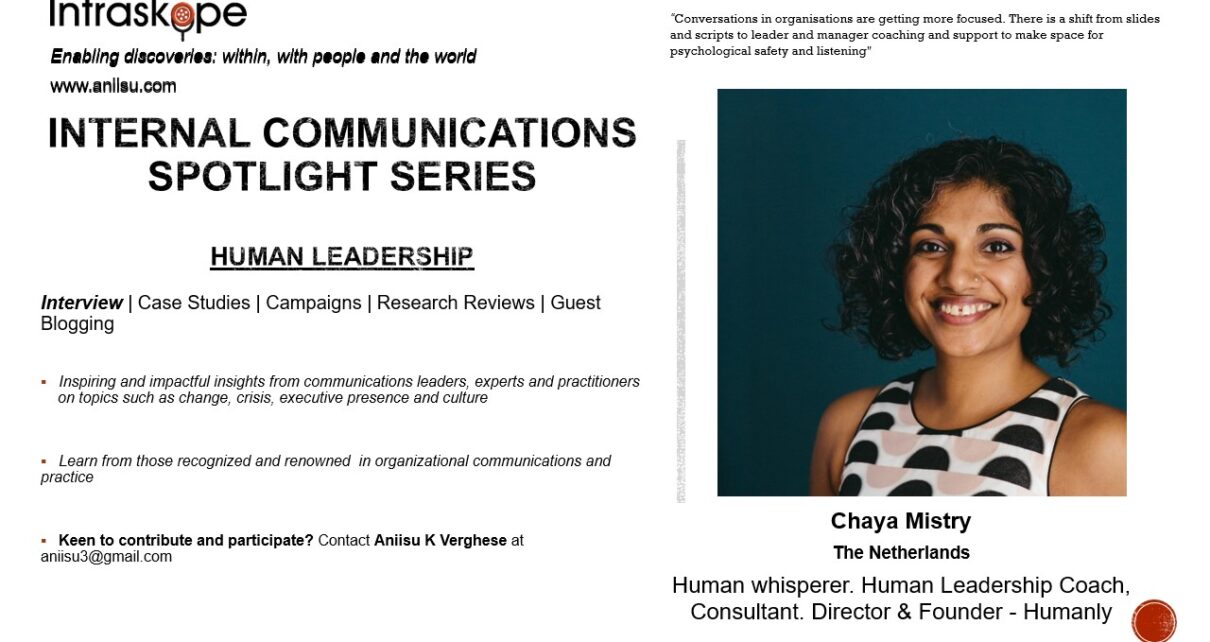How human is our leadership? How must we be engaging to motivate staff and create a sense of belongingness? What approaches will help us be more ‘human’ in our everyday interactions as communicators?
In this chat with Chaya Mistry, I cover the need and value of staying grounded, taking people along and driving change in a human way.
Welcome to the 29th edition of Intraskope’s Spotlight Series featuring Chaya Mistry, a global communications coach and trainer who builds human potential through connection. Based in The Netherlands, Chaya is a communications consultant and coach with experience and deep expertise in human face to face communication, engagement, change and leadership coaching.
In this interview, we converse about the evolving trends that has taken away the focus from people and made us lose connections. By being self-aware, investing in building psychological safety and listening empathetically, we can bring ‘human’ back into the conversation, believes Chaya.
Interview
- How do you define human leadership?
What it is? It is difficult to explain.
How it makes you feel? Start with the end in mind. How do you want to feel – to be seen, heard, safe, valued, motivated, respected, connected and collaborative. What that asks of leaders is to listen, be purpose driven, communicate clearly and respectfully, hold space, lift people up, see and bring out their best qualities and help them feel good about who they are.
Also, to be curious without judgement. Being self-aware of your own strengths and weaknesses and have strategies for how to manage them. It helps to be networked and skilled at building positive meaningful relationships.
Do right things – not easy things. Feel and manage emotions of self and others. But that is hard – since you got to be aware of them irrespective where you are – be it at school, work or in your leadership role.
- Why is it relevant in today’s world?
We are seeing a number of trends.
– Climate challenge and how we focus on facts over feelings. We need to understand that behaviour change happens at an emotional level.
– Social change means considering people in systems
– With digitalisation, it gets harder to lead humanly
3. How does it impact how we communicate, especially with staff?
For example, during change, we need to be communicating continuously or people may get fooled into a false sense of security. Also, if we don’t adopt a human approach employees can get ‘demoralised into performance’. It isn’t possible to get diversity without making space for inclusion and belonging.
4. What are the key elements of human leadership?
According to me, they are: Courage, Compassion, Curiosity, Emotional Quotient, Communication Quotient, Communication skills and Systems thinking.
5. What can internal communications do to incorporate this into their everyday work?
They can humanise people; in stories and measure the impact qualitatively. It boils down to emotions fluency and objectives. The questions are – what we want them to feel and what do they want to feel or not feel? For human leadership to work, the systems and networks outside your organisational structure and communication channels must be aligned as well.
6. What are some of the best practices you have observed?
Conversations in organisations are getting more focused. There is a shift from slides and scripts to leader and manager coaching and support to make space for psychological safety and listening. It is valuable to have questions and conversations that create connection. Also feedback for leaders is relevant.
7. What advice do you have for leaders and communicators to practice human leadership through communications?
They are not separate issues. We cannot lead humanly without communicating in a human manner. Therefore, the biggest need is self-awareness.
Watch this interview with Chaya to learn more.
In the Spotlight on Internal Communications Series, I talk to thought leaders on topics interrelated with internal communications such as culture, crisis, change, executive presence and leadership. The goal is to help unravel why they matter, what can leaders and communicators learn from experts and how we can put insights to practice.
Watch the complete video interview on YouTube or read the complete transcript above.
Missed the earlier episodes? Watch them here: D. Mark Schumann (Culture), Peter Yorke (Executive Presence), Sia Papageorgiou (Leadership Communications), Dianne Chase (Strategic Storytelling), Gloria Walker (Communication Planning), Rebecca Sangster-Kelly (Stakeholder Management), Ray Walsh (Localizing Employee Communications), Prof. Matt Tidwell (Reputation), Geri Rhoades (Manager Communications), Erik K Meyers (Business Acumen), Russell-Olivia Brooklands (IC Practice Governance), Paul Barton (Public Speaking and Business Communication), Cyrus Mavalwala (Digital Communication), Elvera N Makki (Social Impact Communication), Philippe Borremans (Communication Preparedness), Magdalena Petryniak (Influence in Communications), Priya Bates (Communicating Diversity & Inclusion), Zora Artis (Communication Alignment), Diana Bonczar (Communication Execution), Jane McConnell (Gig Mindset), Paul Mathews (Trust & Communications), Brad Whitworth (Creativity in Communication), Zane Ewton (Podcasting), Andrea Greenhous (Employee Experience) and Jonas Bladt Hansen (Digital Technologies), Luis Suarez (Data Analytics & KM) , Laura McHale (Neuroscience in Communications) and Christopher Flores (Internal Communication Hiring).
You can also look up the ongoing Intraskope’s Spotlight on Internal Communication Series featuring practitioners from around the globe sharing best practices and perspectives.
Liked the interview? Post your comments and share it with your network.
Keen to participate in the ongoing series on Personal Branding, Crisis Communications, Internal Communications or CSR Communications? Drop me a note at [email protected]
Here are Internal Communications resources you can use:
- Learn: Internal Communications Fundamentals Course on Thinkific
- Internal Communications Series: https://forms.gle/KcqmPzLwq7NQi5Km6
- Chat with Aniisu – Internal Communications: https://www.instamojo.com/intraskope/connect-with-aniisu-60-minute-personalized-d/?ref=store
- Internal Communications workshops: https://bit.ly/2zdBRl1
You can also visit my website www.intraskope.com and You Tube channel to know more about my work.
#IC #human #internalcomms #humancomms #safety #humanpotental #leadercomms organizationalcomms #Ipurpose #messaging #leadership #management #communication #internalcomms #communications #internalcommunications #covid19 #ChayaMistry #courage #compassion #curiosity #emotionalquotient #EQ #communicationquotient #communication #skills #systemsthinking



